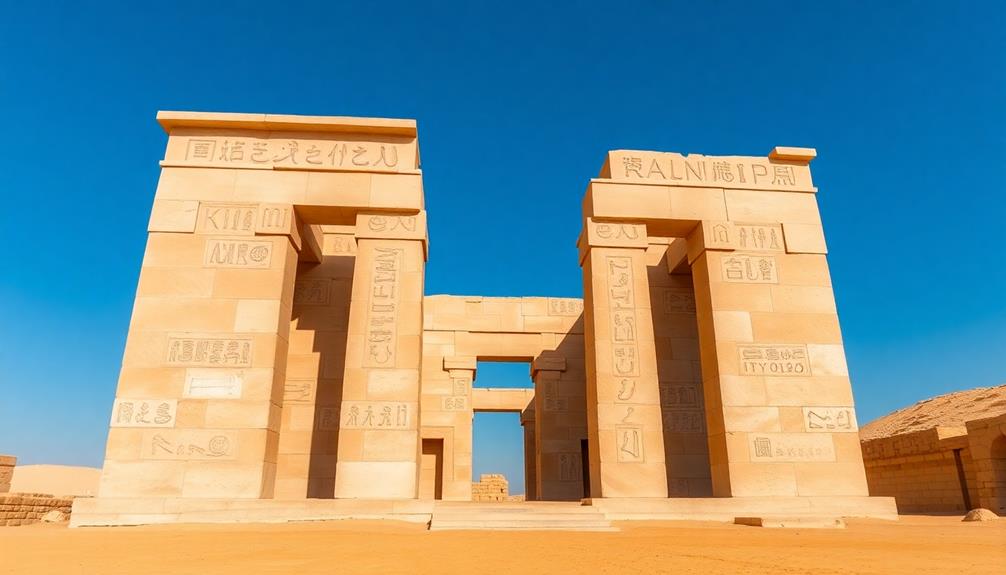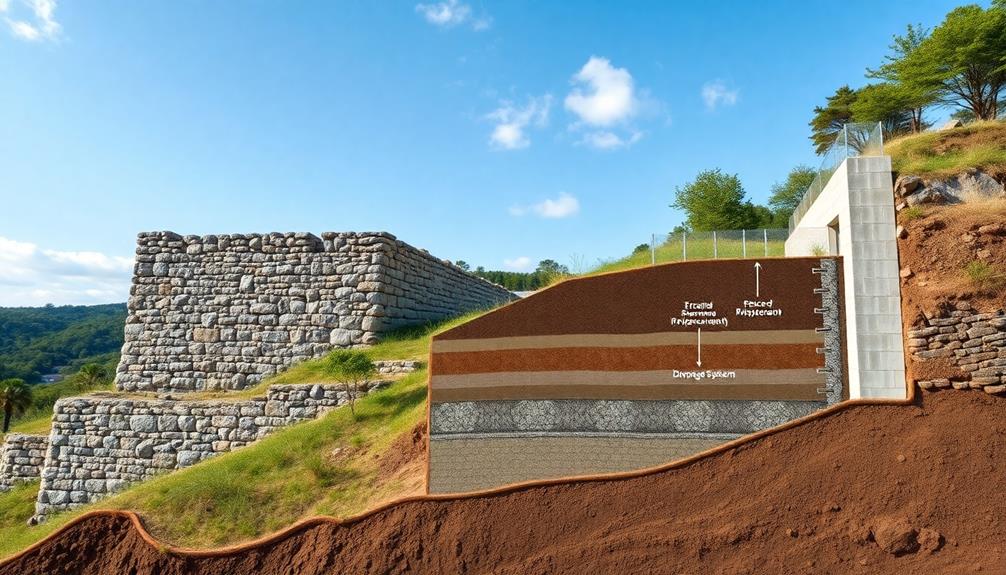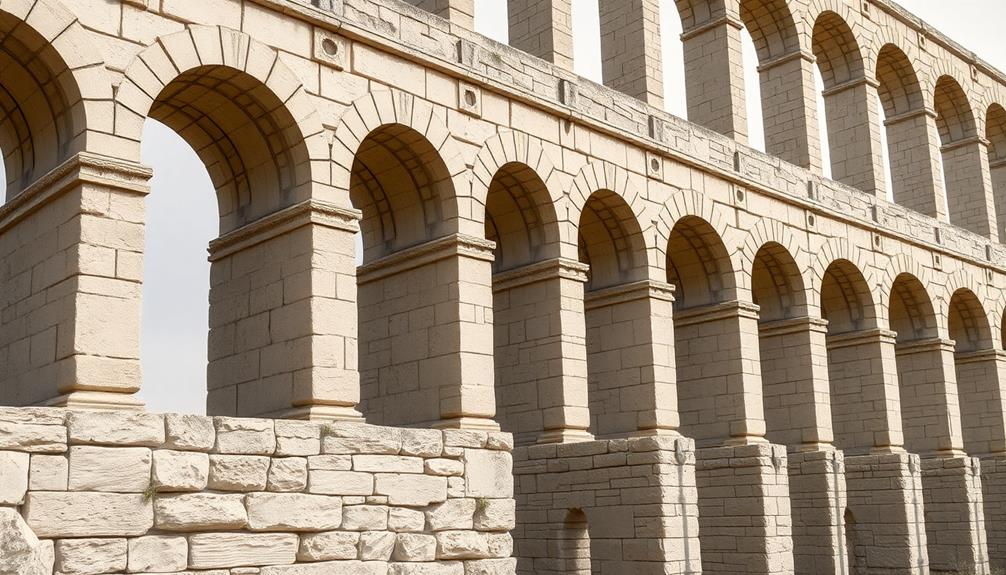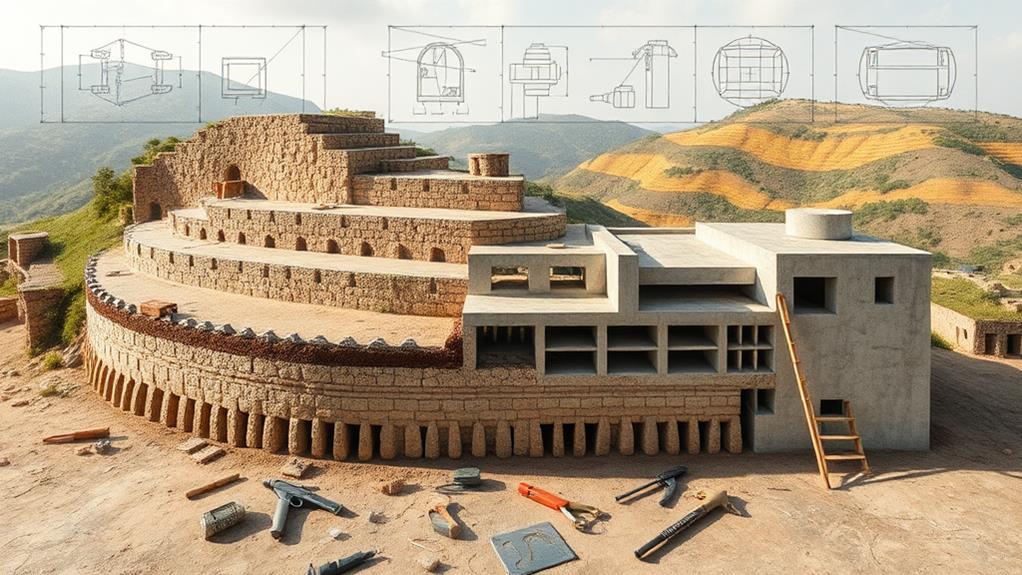The historical development of retaining wall engineering demonstrates a remarkable progression from ancient Egyptian stone structures to sophisticated Roman concrete applications. Egyptian engineers pioneered gravity walls, exemplified by the iconic pyramids, and developed innovative techniques for temple foundations and Nile embankment stabilization. Roman advancements in concrete technology, particularly the Opus Caementicium technique utilizing hydraulic lime mortar and pozzolana volcanic ash, revolutionized retaining wall construction. This innovation enabled the creation of stronger, more durable structures capable of withstanding significant lateral earth pressures. These ancient engineering marvels laid the foundation for modern retaining wall design principles, showcasing the enduring impact of early civilizations on contemporary construction practices. Further exploration of this topic reveals fascinating insights into the evolution of civil engineering.
Table of Contents
ToggleWalls Contractor Highlights
- Ancient Egyptians pioneered retaining wall engineering with pyramids, temple foundations, and Nile embankment stabilization techniques.
- Roman engineers revolutionized retaining wall construction with Opus Caementicium, using hydraulic lime mortar and pozzolana volcanic ash.
- The pozzolanic reaction in Roman concrete significantly improved the strength and durability of retaining walls.
- Advancements in retaining wall technology enabled slope stabilization, flood protection, and aesthetic landscape solutions.
- Modern retaining wall engineering incorporates geotextiles, computer-aided design, and diverse materials for optimized performance and aesthetics.
Ancient Egyptian Stone Structures

The ancient Egyptians demonstrated remarkable engineering prowess in their stone structures, utilizing principles that resonate with modern retaining wall design. Their iconic pyramids functioned as massive gravity walls, relying on sheer weight and precise stone placement to maintain stability over millennia.
Much like specialized equipment used in modern retaining wall construction, ancient Egyptians likely employed innovative tools and techniques to guarantee structural integrity.
Beyond the pyramids, Egyptian engineers implemented sophisticated retaining systems in temple foundations and along the Nile's banks, employing techniques to stabilize embankments against the river's annual floods and safeguard the longevity of their monumental architecture.
Pyramids as Gravity Walls
Ancient Egyptian pyramids stand as monumental examples of gravity walls, utilizing their immense weight and precisely engineered structure to resist lateral earth pressures. These colossal structures, constructed over 4,500 years ago, demonstrate a sophisticated understanding of structural mechanics and soil retention principles.
The pyramids' sloped sides and broad bases distribute the enormous weight of the stone blocks, effectively counteracting the horizontal forces exerted by the surrounding earth.
The construction process involved meticulously stacking limestone blocks in a stepped pattern, with each successive layer slightly inset from the one below. This technique not only enhanced stability but also facilitated the creation of a smooth, angled exterior surface.
The pyramids' internal structure often incorporated additional supporting walls and chambers, further reinforcing their ability to withstand both gravitational and lateral loads. The ancient Egyptians' mastery of geometry and engineering allowed them to create these enduring monuments, which have withstood millennia of environmental stresses and seismic activity.
The principles employed in pyramid construction continue to inform modern retaining wall design, particularly in the domain of gravity walls for large-scale earthworks and infrastructure projects.
Temple Foundation Retaining Systems
Foundations of ancient Egyptian temples exemplify sophisticated retaining systems that played a pivotal role in preserving these monumental structures for millennia. These systems, meticulously engineered to withstand the test of time, incorporated innovative techniques that continue to inspire modern civil engineers. The temple foundations typically consisted of multiple layers of limestone blocks, carefully arranged to distribute the immense weight of the superstructure and resist lateral earth pressures.
The ancient Egyptian engineers employed a stepped foundation design, where each successive layer expanded outward, creating a stable base that effectively countered the tendency for the structure to sink or tilt. This method not only enhanced structural integrity but also allowed for the construction of temples on uneven terrain. Additionally, they utilized a system of interlocking stones and precise joinery, which minimized settlement and increased the foundation's resistance to seismic activity. The incorporation of drainage channels within the foundation further protected against water damage and erosion, ensuring the longevity of these sacred edifices. These ancient retaining systems serve as a record, documentation, or chronicle to the ingenuity of early engineers and continue to inform contemporary practices in foundation design.
Nile Embankment Stabilization Techniques
Embankments along the Nile River posed significant engineering challenges for ancient Egyptians, who developed sophisticated techniques to stabilize these critical structures. The Nile's annual flooding cycle necessitated robust solutions to prevent erosion and maintain the integrity of riverbanks. Egyptian engineers employed a combination of stone masonry and earthen reinforcement methods to achieve long-lasting stability.
One prominent technique involved the construction of stepped stone revetments. These structures consisted of carefully placed limestone blocks arranged in a series of receding tiers, effectively dissipating the force of floodwaters and reducing erosion. The Egyptians also incorporated vegetation into their embankment designs, utilizing the root systems of native plants to bind soil particles and increase overall stability. Additionally, they implemented a system of interconnected drainage channels to manage water flow and prevent saturation of the embankment core. These channels, often lined with stone or clay, directed excess water away from vulnerable areas, thereby minimizing the risk of structural failure. The ancient Egyptians' innovative approach to embankment stabilization laid the groundwork for future developments in retaining wall engineering and continues to inform modern riverbank management practices.
Benefits

Retaining walls offer numerous advantages that extend beyond their primary function of holding back soil. These engineered structures drastically improve land utilization by creating usable space on sloped terrain, while simultaneously enhancing slope stability and mitigating the risk of landslides or erosion.
Limestone wall installation provides excellent support and prevents erosion, adding an elegant and natural look to any yard or home. Retaining walls can also be customized to fit specific needs and design preferences.
Correspondingly, retaining walls can serve as effective flood protection measures and provide aesthetically pleasing landscape solutions, seamlessly blending functionality with visual appeal in both urban and rural environments.
Improved Land Utilization
Through the implementation of retaining walls, property owners can substantially enhance land utilization. These structures enable the creation of usable, level surfaces on previously sloped or uneven terrain, effectively expanding the functional area of a property. By strategically employing retaining walls, landowners can transform challenging topography into valuable assets, maximizing the potential of their real estate investments.
Retaining walls offer numerous advantages for improved land utilization:
- Erosion control: Stabilizing soil and preventing sediment runoff
- Increased property value: Creating additional usable space and aesthetic appeal
- Enhanced landscaping opportunities: Allowing for tiered gardens and multi-level outdoor living areas
The evolution of retaining wall engineering has profoundly contributed to urban development and infrastructure expansion. In densely populated areas, where space is at a premium, these structures have become indispensable for optimizing land use. By supporting hillsides and creating terraced landscapes, retaining walls have facilitated the construction of buildings, roads, and railways in previously inaccessible locations. This ability to reclaim and repurpose challenging terrain has played a vital role in accommodating growing populations and expanding urban centers, ultimately shaping the modern built environment we inhabit today.
Enhanced Slope Stability
One of the primary benefits of retaining walls is their ability to greatly enhance slope stability. These structures play a vital role in mitigating the risks associated with unstable terrain, particularly in areas prone to landslides or erosion. By providing lateral support to soil masses, retaining walls effectively redistribute the forces acting on a slope, creating a more balanced and secure environment. This enhanced stability not only protects existing infrastructure but also opens up previously unusable land for development.
The engineering principles behind slope stabilization through retaining walls have evolved remarkably over time. Modern designs incorporate advanced materials and construction techniques to maximize effectiveness. Geotextiles, for instance, are often integrated into retaining wall systems to improve drainage and further reinforce soil structure. Additionally, the use of computer-aided design and analysis tools has allowed engineers to optimize wall configurations for specific site conditions, ensuring maximum stability with minimal material usage. These advancements have made it possible to stabilize increasingly challenging slopes, expanding the potential for safe and sustainable land use in diverse geographical contexts.
Flood Protection Capabilities
A crucial yet often overlooked benefit of retaining walls is their capacity to provide flood protection. These structures serve as critical barriers against rising water levels, particularly in areas prone to flooding or adjacent to water bodies. By effectively managing water flow and distribution, retaining walls play a pivotal role in safeguarding communities, infrastructure, and valuable assets from the devastating impacts of floods.
The flood protection capabilities of retaining walls are multifaceted, offering several key advantages:
- Mitigation of erosion and soil instability caused by floodwaters
- Redirection of water flow away from vulnerable areas
- Creation of controlled drainage pathways to manage excess water
As urban development continues to expand into flood-prone regions, the importance of incorporating flood protection measures into retaining wall design has become increasingly apparent. Engineers and urban planners now recognize the dual functionality of these structures, not only in maintaining soil stability but also in bolstering community resilience against flood events. This evolving perspective has led to significant advancements in retaining wall engineering, with innovative designs and materials being employed to enhance their flood protection capabilities while seamlessly integrating into the urban landscape.
Aesthetic Landscape Solutions
Beyond their structural and protective functions, retaining walls offer significant aesthetic benefits to landscapes. These engineered structures seamlessly blend functionality with visual appeal, transforming otherwise challenging terrains into attractive, usable spaces. Retaining walls can be designed to complement existing architecture or natural surroundings, creating a cohesive and harmonious environment that enhances property value and curb appeal.
The aesthetic versatility of retaining walls is exemplified through the diverse range of materials available, including natural stone, brick, concrete blocks, and even recycled materials. Each option presents unique textures, colors, and patterns that can be tailored to suit specific design preferences. Additionally, retaining walls provide opportunities for creative landscaping solutions, such as tiered gardens, elevated planting beds, and water features. These elements not only add visual interest but also contribute to the overall ecosystem of the space.
Early Roman Concrete Applications

The Romans revolutionized construction with their innovative concrete applications, particularly in retaining wall engineering. Their Opus Caementicium technique, which utilized hydraulic lime mortar and pozzolana volcanic ash, created structures of unprecedented strength and durability. This early Roman concrete technology laid the foundation for modern retaining wall design, demonstrating remarkable longevity and resilience against environmental forces.
| Roman Concrete Component | Function | Modern Equivalent |
|---|---|---|
| Hydraulic Lime Mortar | Binding agent | Portland cement |
| Pozzolana Volcanic Ash | Strength enhancer | Fly ash |
| Aggregate (Caementa) | Structural bulk | Gravel or crushed stone |
Opus Caementicium Construction Techniques
Opus caementicium, a revolutionary Roman construction technique, marked a substantial advancement in retaining wall engineering during antiquity. This innovative method, which translates to "concrete masonry," allowed for the creation of stronger, more durable structures capable of withstanding considerable lateral earth pressures. The process involved layering rubble and stones with a mortar mixture composed of lime, pozzolana ash, and water, resulting in a remarkably cohesive and resilient material.
The opus caementicium technique offered several advantages over traditional dry-stone construction:
- Enhanced structural integrity due to the binding properties of the mortar
- Increased flexibility in design, allowing for curved and complex wall shapes
- Improved water resistance, reducing deterioration from moisture infiltration
Roman engineers refined this method over time, developing sophisticated formwork systems and perfecting mortar recipes to optimize strength and durability. The implementation of opus caementicium in retaining wall construction enabled the Romans to build taller, more robust structures capable of supporting extensive terracing and fortifications. This technological breakthrough facilitated the expansion of Roman infrastructure, including aqueducts, harbor installations, and hillside developments, contributing extensively to the empire's architectural legacy and influencing construction practices for centuries to come.
Hydraulic Lime Mortar Innovation
Pioneering advancements in hydraulic lime mortar marked a pivotal step in the development of early Roman concrete applications. This innovative material, composed of lime and volcanic ash, possessed remarkable properties that revolutionized construction techniques. When mixed with water, the mortar underwent a chemical reaction, forming a durable and water-resistant substance capable of withstanding significant structural loads.
The Romans' mastery of hydraulic lime mortar enabled them to construct formidable retaining walls that could resist the lateral pressures of soil and water. This breakthrough allowed for the expansion of urban infrastructure, including aqueducts, bridges, and harbor installations. The mortar's ability to set underwater proved particularly advantageous in maritime engineering projects, facilitating the construction of breakwaters and seawalls that protected coastal settlements from erosion and storm surges.
The widespread adoption of hydraulic lime mortar in retaining wall construction fostered a sense of technological superiority among Roman engineers and builders. This shared knowledge and expertise contributed to a collective identity rooted in engineering prowess, uniting professionals across the empire in their pursuit of architectural excellence and structural innovation.
Pozzolana Volcanic Ash Usage
Integral to the development of hydraulic lime mortar was the use of pozzolana volcanic ash, a key component in early Roman concrete applications. This innovative material, derived from volcanic deposits near Pozzuoli, Italy, revolutionized construction practices in ancient Rome. When mixed with lime and water, pozzolana created a remarkably durable and water-resistant concrete, enabling the construction of massive structures that have endured for millennia.
The Romans' mastery of pozzolana-based concrete allowed them to build:
- Monumental structures like the Pantheon and Colosseum
- Extensive aqueduct systems spanning great distances
- Robust harbor installations resistant to seawater erosion
This groundbreaking technology facilitated the expansion of Roman infrastructure across their vast empire. The pozzolanic reaction, which occurs between the silica and alumina in the ash and the calcium hydroxide in lime, produces calcium silicate hydrate compounds that impart exceptional strength and durability to the concrete. This advanced understanding of material properties enabled Roman engineers to construct retaining walls capable of withstanding significant lateral earth pressures, paving the way for more complex and ambitious architectural endeavors throughout the ancient world.
Walls Contractor FAQ
How Do Modern Seismic Design Considerations Affect Retaining Wall Construction?
Modern seismic design considerations profoundly impact retaining wall construction. Engineers now incorporate flexible materials, reinforcement techniques, and dynamic load analysis to bolster wall stability during earthquakes. These advancements guarantee safer structures for our communities, protecting lives and property.
What Role Does Soil Mechanics Play in Retaining Wall Engineering?
Soil mechanics is fundamental in retaining wall engineering, guiding our collective understanding of soil behavior, strength, and stability. It informs pivotal decisions on wall design, foundation requirements, drainage systems, and overall structural integrity, ensuring our projects' success and safety.
How Have Computer Simulations Improved Retaining Wall Design and Analysis?
Computer simulations have revolutionized retaining wall design and analysis, allowing us to model complex soil-structure interactions, predict performance under various conditions, and optimize designs for safety and efficiency. This technology has greatly enhanced our ability to create reliable, cost-effective solutions.
What Are the Environmental Impacts of Different Retaining Wall Materials?
Different retaining wall materials have varying environmental impacts. Concrete production emits significant CO2, while timber walls may contribute to deforestation. Steel requires energy-intensive manufacturing, but recycled options exist. Gabion and natural stone walls often have lower environmental footprints.
How Do Climate and Weather Patterns Influence Retaining Wall Longevity?
Climate and weather greatly impact retaining wall longevity. Factors like freeze-thaw cycles, moisture levels, and temperature fluctuations can cause material degradation, soil erosion, and structural stress. Regular maintenance and appropriate design choices help mitigate these effects, ensuring long-term stability and performance.







